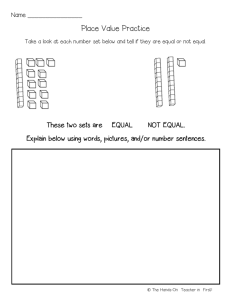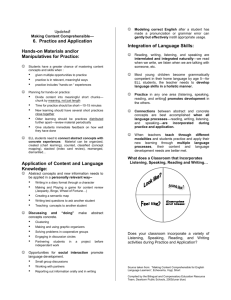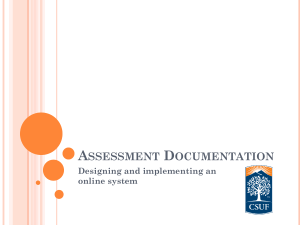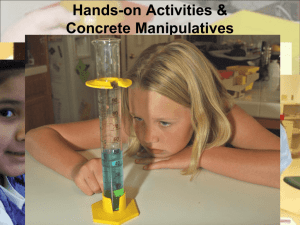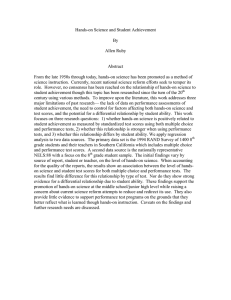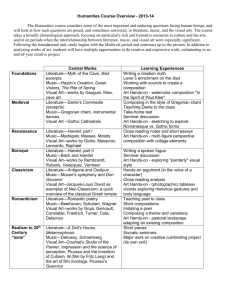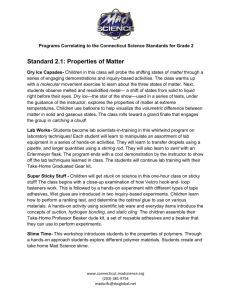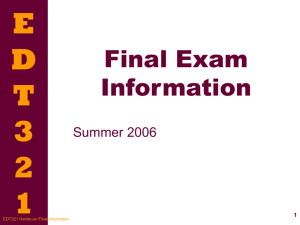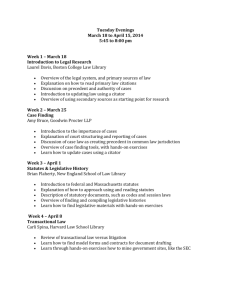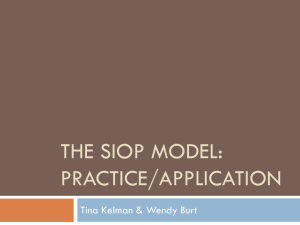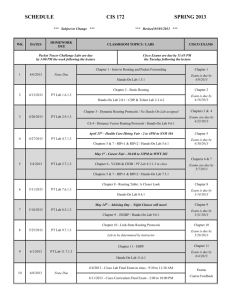SIOP Chapter 7 - Moroni-ITEP
advertisement
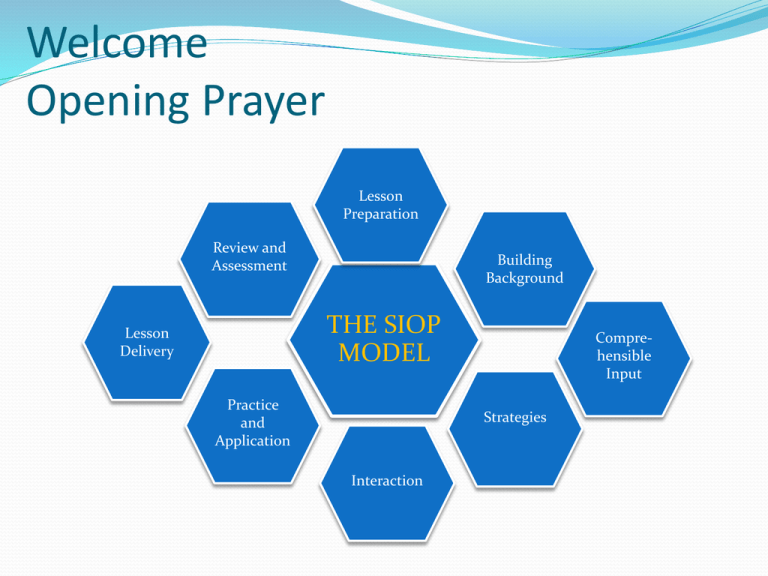
Welcome Opening Prayer Lesson Preparation Review and Assessment Building Background THE SIOP MODEL Lesson Delivery Practice and Application Comprehensible Input Strategies Interaction Interaction: Assignment Choose a lesson plan you will be teaching in the next week. 2. Include two different grouping structures to provide students the opportunity to interact with each other. 3. Teach the lesson. 4. Write a one paragraph reflection stating 1. a. b. c. How the students respond? Were the learning objectives met? How do you know? If you were to teach the lesson again, what would you do differently? 5. Turn in a copy of the lesson plan and the reflection to Sister Rasmussen. 6. Due Thurs. July 4, 2013 Content Objectives: I will identify a variety of ways for students to enhance their learning through hands on practice. I will create application activities that extend the learning in new ways. Language Objectives: I will discuss and write the answers to the four questions to remember when planning lessons involving hands on activities. Practice/Application New Language and Content Knowledge Presented In Lesson F20: Hands-On Practice with New Knowledge F 22: Integration of Language Skills Content F 21: Application of New Knowledge in New Ways Language Guided Practice “When learning to ride a bicycle, play the piano, or articulate how convex lenses differ from concave, students have a greater chance of mastering content concepts and skills when they are given multiple opportunities to practice in relevant, meaningful ways.” Do you agree or disagree? Turn and talk to your neighbor and be prepared to share. F 20: Hands-On Practice Questions and Answers! (From the work of Madeline Hunter) 1. How much material should be presented at one time? Answer: A short, meaningful amount. Always use meaning to divide your content into parts. 2. How long in time should a practice period be? Answer: A short time so he student exerts intense effort and has intent to learn. Hands-On Practice Questions and Answers! (continued…) 3. How often should students practice? Answer: New learning, massed practice. Older learning: distributed practice. (Hunter explains that massed practice means several practice periods scheduled close together. Distributed practice means several practice periods farther and farther apart, such as when we review previously learned material.) 4. How will students know how well they have done? Answer: Give immediate and specific knowledge of results. “Although all students benefit from guided practice, English learners make more rapid progress … when they are provided with multiple opportunities to practice with handson materials and/or manipulatives. These may be organized, created, counted, classified, stacked, experimented with, observed, rearranged, dismantled, and so forth. Manipulating learning materials is important for ELs because it helps them connect abstract concepts with concrete experiences.” Practice the real thing!!! Just think about the difference between talking about riding a bike, and actually riding it. Think about the difference between a how-to guide on playing the piano, and actually playing it. “The difference between knowing how something should be done and being able to do it is the quantum leap in learning.” F21: Activities Provided for Students to Apply Content and Language Knowledge •“Discussing” and “DOING” make abstract concepts concrete. •Application or “DOING” must also include opportunities for them to practice language knowledge (Reading, Writing, Speaking, Listening) in the classroom. •The classes we remember best are the ones in which we applied our new knowledge in meaningful ways. Think, Pair, Share Think about a class you have taken. What is one activity you remember well? Did it involve different learning styles? Now think about a lesson you have recently taught. Was there an activity that would be memorable for the students? If not, how could the activity have been more engaging and unforgettable? F 22: Activities Integrate All Language Skills Provide opportunities for social interaction, such as: Discussion/working as a class, in a small group, or in pairs “Report out” orally or in writing Explain a process to a peer using the language of instruction—the new learning Describe the results of an experiment Tell why a character reacted in a particular way List the steps in a process Big, Important Question When, under what circumstances, do you correct students’ language errors? In their ZPD… “Zone of Level of Proximal development Development” Current level of development (can be learned with “scaffolding”) currently out of reach Integration of Language Skills Effective teachers understand the need to create many opportunities for students to practice and use all four language processes in an integrated manner. Read about the content Listen to peers’ ideas Write about what is being learned Talk about ideas with a partner or in a group The Frame Up Draw a frame about 1 inch from the outside edge Write “Practice and Application” in the Center On each of the four sides of the frame write: 1. How much? 2. How long? 3. How often? 4. How will I know? With your partner, discuss and write the answers to the four questions. Be prepared to share your answers with the class, along with examples. Summary 1) Practice and application are needed to learn new material. 2) Hands-on activities and materials enable students to forge connections between abstract and concrete concepts. 3) Students make these connections most effectively when using all four language processes during learning. Practice/Application Assignment Choose 3 content/language objectives Create an application activity that will extend the learning in a new way. For example: LO: I will discuss and write the answers to the four questions to remember when planning lessons involving hands on activities Activity: Using the “Frame Up” Activity – The teachers will write the four questions on each side of the paper frame. They will write the answers to the questions inside the frame. Content Objectives: I will identify a variety of ways for students to enhance their learning through hands on practice. I will create application activities that extend the learning in new ways. Language Objectives: I will discuss and write the answers to the four questions to remember when planning lessons involving hands on activities.
